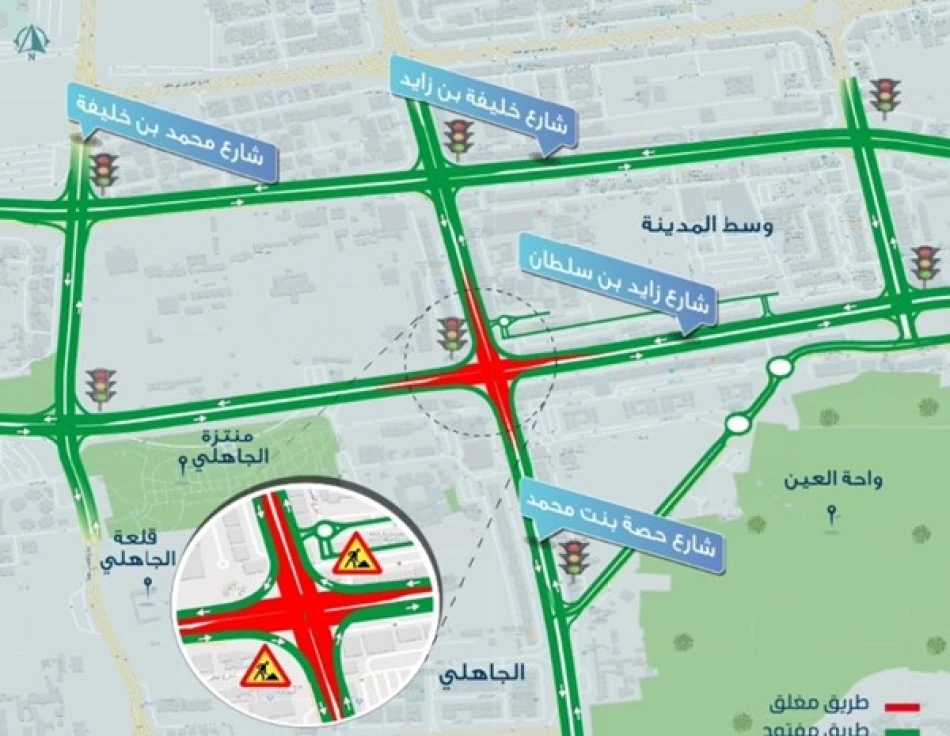
Temporary Closure of Zayed bin Sultan and Hessa bint Mohammed Intersection in Al Ain
Major Al Ain Traffic Disruption: Key Intersection Closure Signals Infrastructure Overhaul
The Integrated Transport Centre has announced a temporary closure of the critical intersection between Zayed bin Sultan Street and Hessa bint Mohammed Street in Al Ain from Saturday, August 16, 2025, through Monday, August 25, 2025. This nine-day shutdown of one of the emirate's busiest traffic arteries reflects the UAE's accelerating infrastructure modernization drive as the country prepares for sustained economic growth.
Strategic Location Impact
The closure affects a vital commercial and residential hub in Al Ain, the UAE's fourth-largest city and a UNESCO World Heritage site. Zayed bin Sultan Street serves as a primary thoroughfare connecting residential districts to commercial centers, while Hessa bint Mohammed Street links educational institutions and government facilities to the broader urban network.
This intersection handles an estimated 15,000-20,000 vehicles daily, making it one of Al Ain's most congested points during peak hours. The timing suggests authorities are leveraging the traditionally quieter August period, when many residents travel abroad, to minimize economic disruption.
Infrastructure Investment Surge
The closure aligns with the UAE's $13.6 billion infrastructure investment plan announced in early 2024, which prioritizes smart traffic systems and road capacity expansion. Al Ain, as the birthplace of the UAE's founding father Sheikh Zayed, receives particular attention in national development strategies.
Economic Implications
Local businesses should brace for temporary revenue impacts, particularly retail outlets and restaurants dependent on drive-by traffic. However, historical data from similar UAE infrastructure projects suggests a 15-25% increase in commercial activity typically follows major road improvements within six months of completion.
Real estate values in the immediate vicinity often see modest appreciation following infrastructure upgrades, as improved accessibility enhances property desirability for both residential and commercial purposes.
Regional Context
This closure mirrors infrastructure acceleration patterns across the Gulf. Dubai's recent completion of the Shindagha Bridge project and Abu Dhabi's ongoing Reem Island connectivity improvements demonstrate the UAE's commitment to preemptive infrastructure development rather than reactive congestion management.
Unlike traffic management approaches in older cities globally, the UAE's strategy focuses on anticipating growth rather than responding to existing bottlenecks. This forward-looking approach has consistently supported the country's economic diversification goals and tourism sector expansion.
Operational Considerations
Commuters should expect significant delays on alternative routes, particularly Al Khaleej Al Arabi Street and Sheikh Khalifa bin Zayed Street. The nine-day duration suggests comprehensive work beyond routine maintenance—likely involving smart traffic signal installation, underground utility upgrades, or intersection geometry modifications.
The Monday completion date strategically positions the reopening for the start of a new business week, allowing immediate assessment of traffic flow improvements and system optimization during peak usage periods.
Most Viewed News

 Layla Al Mansoori
Layla Al Mansoori






